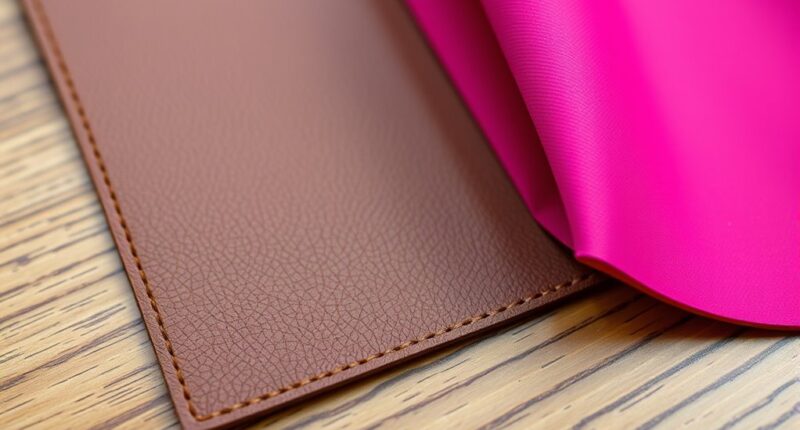The No‑Nonsense Guide to Leather Vs Synthetic Care Glossary helps you understand the main differences between genuine leather and faux options, including feel, smell, aging, and durability. It explains key terms like conditioners, protectants, and patina, and shows you which products are suitable for each material. You’ll also learn how to spot signs your items need care and choose the right products. Keep going to get clear steps for keeping your leather and synthetic pieces in top shape.
Key Takeaways
- Understand the differences in feel, smell, aging, and durability between genuine leather and faux/synthetic leather.
- Recognize key terminology like leather conditioning, patina, and synthetic materials to choose appropriate care products.
- Use suitable cleaners, conditioners, and protectants specifically designed for leather or synthetic surfaces.
- Avoid harsh chemicals like alcohol, petroleum solvents, or synthetic dyes that can damage either material.
- Regularly inspect items for signs of wear, cracks, or fading to determine when and how to properly care for each material type.
Key Differences Between Leather and Synthetic Materials
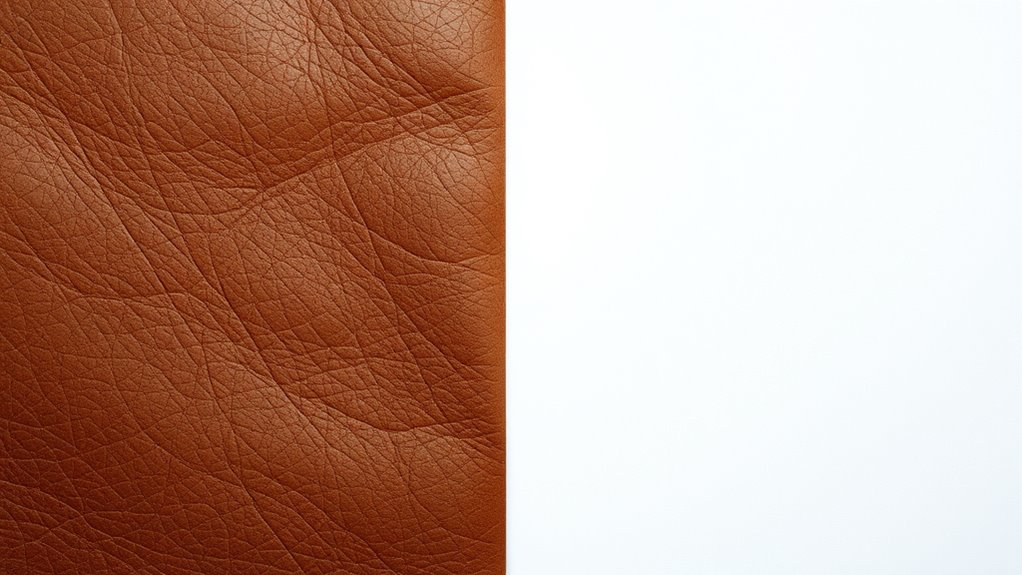
Leather and synthetic materials differ substantially in their composition and characteristics. Faux leather offers decent durability, but it generally doesn’t match genuine leather’s longevity. Faux leather’s durability can vary based on quality, but it typically wears faster and shows signs of aging sooner. Genuine leather, on the other hand, ages gracefully. Over time, it develops a unique patina, adding character and value to the piece. Unlike synthetic options, genuine leather’s aging process enhances its appearance, making it more attractive with age. Synthetic materials are often easier to maintain and less prone to cracking, but they lack the natural aging process that authentic leather provides. Understanding these differences helps you choose the right material based on how much wear and aging you expect, especially considering the material durability of each type.
Common Terminology in Leather Care
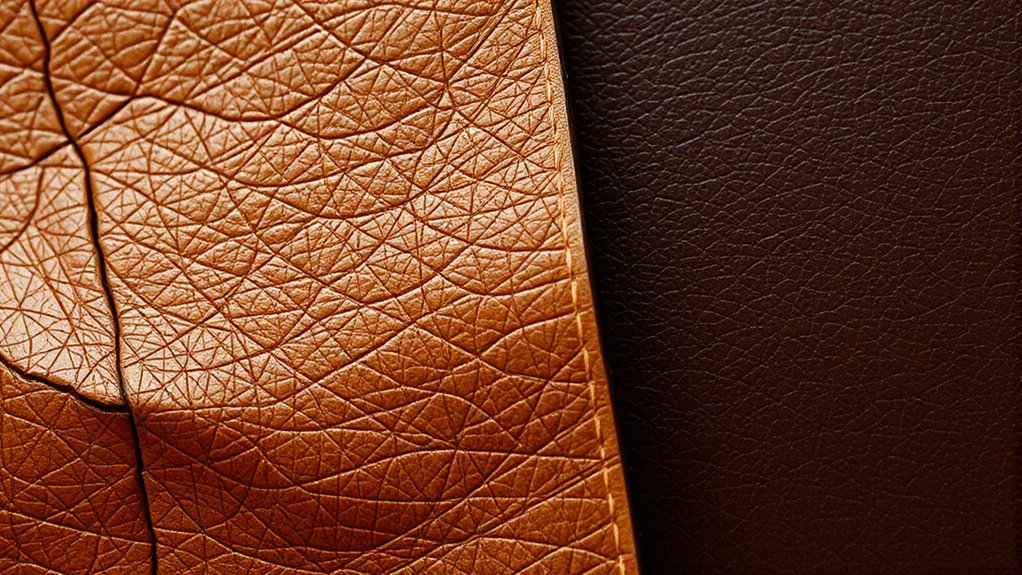
Understanding the terminology used in leather care can seem overwhelming at first, but familiarizing yourself with key terms makes maintaining your items much easier. Leather aging refers to the natural process where leather develops a richer look and softer feel over time, but it can also cause color changes or cracks if not cared for properly. You’ll want to use conditioners designed for leather to slow this process. Synthetic scent describes the artificial smell often found in synthetic materials, which can influence your cleaning choices. Knowing these terms helps you choose the right products and avoid confusion. By understanding how leather ages and recognizing the scent differences, you’ll ensure your leather items stay beautiful and durable longer.
Essential Terms for Synthetic Material Maintenance
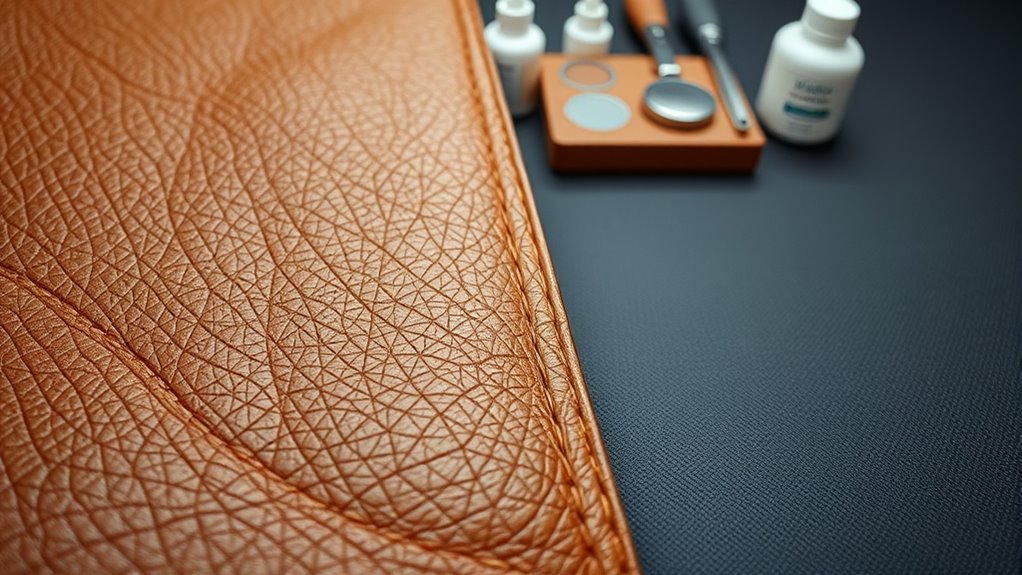
Understanding the different types of synthetic materials helps you choose the right care approach. You also need to know which cleaning agents are compatible to avoid damage. Plus, applying proper preservation techniques keeps your synthetic items looking their best longer. Being aware of the material safety considerations is crucial to prevent unintended harm during maintenance.
Synthetic Material Types
Have you ever wondered about the different types of synthetic materials used in upholstery and accessories? Synthetic materials include various options like faux leather and synthetic textiles. Faux leather mimics genuine leather with a plastic or polyurethane coating, making it durable and easy to clean. Synthetic textiles, on the other hand, are crafted from fibers like polyester, nylon, or acrylic, offering versatility and affordability. These materials are often chosen for their resistance to stains, wear, and fading. Understanding the specific type of synthetic material helps you choose the right care methods and products. Faux leather requires gentle cleaning to maintain its appearance, while synthetic textiles may need specific treatments to prevent damage. Knowing these differences ensures you properly care for your items and extend their lifespan. Additionally, automation technologies in manufacturing can influence the production quality and consistency of synthetic materials, impacting how they should be cared for over time.
Cleaning Agents Compatibility
Are you aware of which cleaning agents are safe to use on your synthetic materials? Using incompatible cleaners can cause unwanted chemical reactions, damaging the surface. Always check if the cleaner maintains the proper pH balance; harsh pH levels can weaken or discolor your synthetic items. To help, here’s a quick compatibility guide:
| Cleaning Agent | Compatibility |
|---|---|
| Mild soap & water | Safe, maintains pH balance |
| Alcohol-based cleaners | Usually safe, avoid overuse |
| Ammonia solutions | Not recommended, can cause chemical reactions |
| Harsh solvents | Unsafe, may damage material |
Choosing the right agent prevents reactions that could compromise your synthetic material’s integrity. Additionally, it’s important to test cleaners on a small area before full application to ensure compatibility.
Preservation Techniques
Proper preservation techniques are essential to prolong the life and appearance of your synthetic materials. To do this effectively, choose products made through sustainable sourcing and ethical production practices. Regularly clean your synthetic items with gentle, compatible cleaners to prevent dirt buildup without damaging the material. Keep them away from direct sunlight and extreme heat, which can cause fading and cracking. Use protective sprays that create a barrier against stains and moisture, ensuring these products align with eco-friendly standards. Store your items properly, avoiding overcrowding that can cause deformation. Additionally, selecting high-quality materials can significantly enhance the durability and sustainability of your synthetic items. By prioritizing sustainable sourcing and ethical production in your preservation routine, you help reduce environmental impact while maintaining the quality and longevity of your synthetic materials.
Types of Leather Care Products and Their Uses
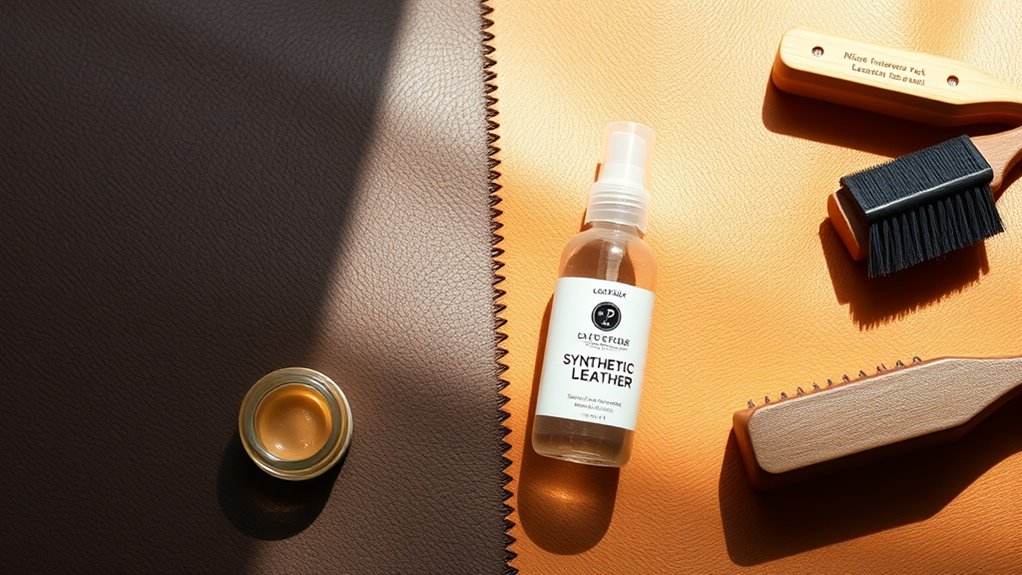
Choosing the right leather care products depends on understanding their specific functions. For example, leather conditioners restore moisture and flexibility, while cleaners remove dirt and grime. If your leather has undergone leather tanning, it needs gentle products that won’t strip natural oils. Synthetic dyeing often requires specialized dyes or color restorers to maintain vibrancy. Protectants create a barrier against water and stains, ideal for daily use. For finished leather, you might opt for polishes that add shine and a layer of protection. Unfinished or raw leather benefits from conditioners that penetrate deeply without altering the texture. Knowing the type of leather and its treatment history helps you pick products that preserve its integrity and appearance effectively. Additionally, understanding different types of leather care products can help you select the most suitable options for your specific needs.
Ingredients to Look for and Avoid in Leather Conditioners
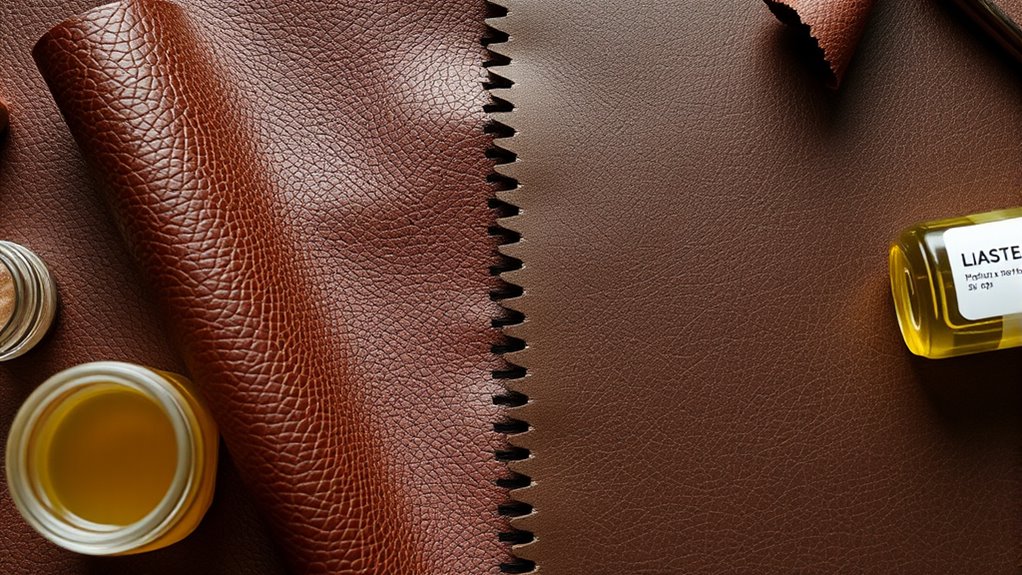
When selecting a leather conditioner, ensuring you pay close attention to its ingredients is *vital*, as they directly impact the product’s effectiveness and your leather’s health. Look for conditioners with natural oils and waxes that support proper leather tanning, promoting moisture and flexibility. Avoid ingredients like alcohol, which can dry out leather, and harsh chemicals that may strip dyes or damage the surface. Be cautious of synthetic dyes in conditioners, as they can interfere with the original leather color and finish. Instead, choose products that enhance the leather’s natural beauty without altering its appearance. Additionally, understanding how certain ingredients affect leather’s durability can help you make better choices for long-term care. By understanding these ingredients, you’ll better protect your leather, keeping it supple, vibrant, and well-maintained over time.
Ingredients to Look for and Avoid in Synthetic Care Products

In selecting synthetic care products, paying attention to their ingredients is just as important as with leather conditioners. Look for eco-friendly options that avoid harsh chemicals like parabens, phthalates, and artificial fragrances, which can damage your materials and harm the environment. Instead, choose products with natural, plant-based ingredients that are gentle yet effective. Avoid petroleum-based solvents and silicones, which can leave residues and reduce breathability. For those interested in DIY care tips, simple ingredients like coconut oil or beeswax can be safe, affordable alternatives. Always read labels carefully, and opt for products that prioritize sustainability and safety. Incorporating yoga principles such as mindfulness and holistic well-being can guide you toward more conscious product choices. By choosing the right ingredients, you can effectively care for your synthetic items without compromising your values or their longevity.
How to Identify Genuine Leather Versus Faux or Synthetic Leather
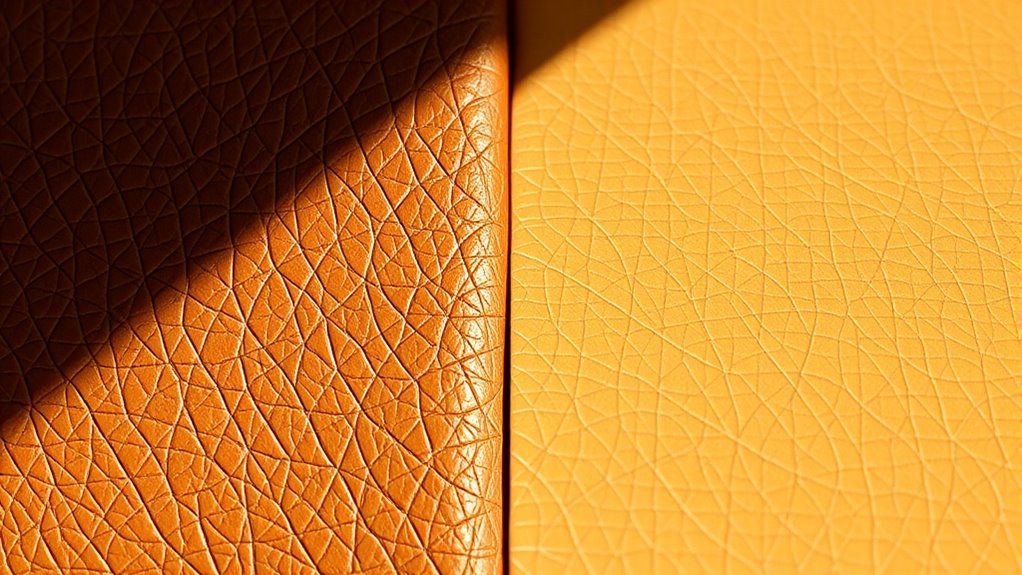
Ever wonder how to tell genuine leather from faux or synthetic alternatives? One of the quickest ways is to feel the texture differences. Genuine leather usually feels soft, supple, and slightly uneven, reflecting its natural origins. Faux leather, on the other hand, tends to be smoother, more uniform, and sometimes plasticky to the touch. Smell distinctions also help: real leather has a rich, earthy scent that’s hard to replicate, while synthetic options often smell like plastic or chemicals. Additionally, genuine leather might develop a patina or slight creases over time, whereas faux materials stay consistent. By paying attention to texture differences and smell distinctions, you can confidently identify authentic leather versus synthetic alternatives. Headphones can be used to listen for subtle audio cues that differentiate genuine from synthetic materials in some cases.
Best Practices for Applying Leather and Synthetic Care Products
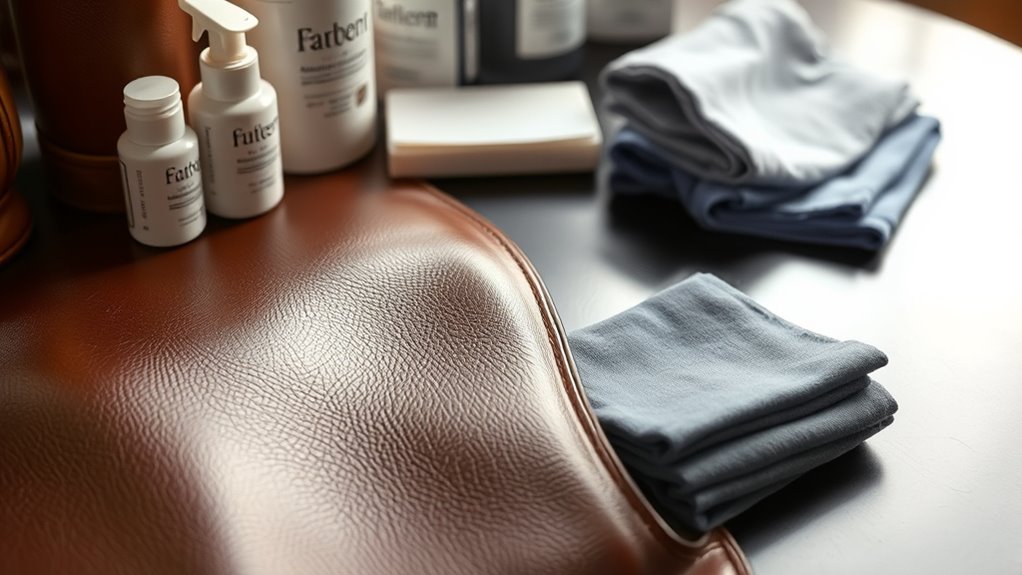
To achieve the best results, you should always start by cleaning your leather or synthetic item thoroughly with a soft, damp cloth to remove dirt and debris. For leather, choose a gentle cleaner that preserves its natural leather scent, avoiding harsh chemicals that can damage the scent or texture. When applying care products, use a soft cloth or sponge, and apply evenly in circular motions. For leather, focus on maintaining its supple, authentic feel, while for synthetic items, ensure the product enhances the synthetic texture without making it sticky or greasy. Always follow the manufacturer’s instructions regarding application amounts and drying times. Proper application prevents damage, preserves appearance, and keeps your leather or synthetic item looking its best longer. Additionally, understanding the proper maintenance of your items can significantly extend their lifespan and appearance.
Signs That Your Leather or Synthetic Items Need Special Attention

You’ll notice when your leather or synthetic items need extra care if they show visible wear and tear or if the material starts to look worn out. Unusual odors can also be a sign that your items require attention to prevent further damage. Paying close attention to these signs helps keep your belongings looking and smelling their best.
Visible Wear and Tear
Visible signs of wear and tear are clear indicators that your leather or synthetic items need some extra care. If you notice fading color, it means the material has been exposed to sunlight or friction, and it’s time for conditioning or protective treatments. Surface scratches are also common signs of damage, especially on leather, revealing the material’s vulnerability. These scratches can deepen over time if ignored, making your item look worn and less appealing. Synthetic materials might show cracks or peeling in areas of frequent use. Addressing these issues early helps maintain the appearance and longevity of your items. Regular inspection and prompt attention prevent minor damage from turning into more costly repairs, ensuring your leather or synthetic belongings stay in good shape longer.
Unusual Odors Appear
Have you noticed a strange or persistent odor emanating from your leather or synthetic items? Unusual odors can signal that your items need special attention. To tackle this, start with odor elimination techniques like airing out your belongings in fresh air or using specialized cleaning products. If the smell lingers, consider scent masking methods such as applying a light layer of fabric freshener or using natural remedies like baking soda. It’s important not to ignore these odors, as they might indicate mold, bacteria, or product breakdown. Regular cleaning and proper storage can prevent future issues. Addressing unusual odors promptly helps preserve your items’ longevity and keeps them smelling fresh and clean.
Tips for Choosing the Right Care Products for Your Accessories

Choosing the right care products for your accessories can considerably extend their lifespan and maintain their appearance. To keep up with lifestyle trends and preserve your fashion accessories, follow these tips:
- Identify the material—leather or synthetic—to select compatible products.
- Read labels carefully to ensure the product suits your accessory type.
- Prioritize gentle, pH-balanced cleaners for delicate surfaces.
- Use a conditioner or protector designed specifically for your accessory’s material to prevent damage and keep it looking new.
Frequently Asked Questions
How Long Do Leather and Synthetic Care Products Typically Last?
Leather care products usually last 6 to 12 months with regular maintenance, depending on usage and environment. Synthetic products tend to last longer, often up to a year or more, due to their durability. To maximize product longevity, you should follow maintenance frequency recommendations and store the products properly. Consistent care helps extend the effectiveness of both leather and synthetic products, ensuring your items stay in good condition longer.
Are There Eco-Friendly Options for Leather and Synthetic Care?
Yes, you can find eco-friendly options for leather and synthetic care. Look for vegan alternatives, which avoid animal products, and biodegradable formulas that break down naturally without harming the environment. These options are better for the planet and often work just as well as conventional products. By choosing eco-friendly care, you’re helping reduce pollution and support sustainable practices in maintaining your leather and synthetic items.
Can Synthetic Leather Be Restored After Damage?
Yes, synthetic leather can be restored after damage. You can use various restoration techniques like cleaning, patching, or applying repair compounds to conceal scratches, tears, or fading. Damage repair is achievable through these methods, helping you extend the life of your synthetic leather items. Regular maintenance and prompt repairs make it easier to keep your synthetic leather looking good, ensuring it stays functional and attractive for years to come.
Is Professional Cleaning Necessary for High-End Leather Goods?
Yes, professional cleaning is necessary for high-end leather goods to guarantee proper leather maintenance. It helps remove dirt, oils, and stains that regular cleaning might miss, preserving the leather’s quality and appearance. By hiring experts, you protect your investment and extend the lifespan of your luxury items. Regular professional cleaning keeps your high-end leather looking pristine and maintains its value over time.
How Can I Prevent Color Fading in Leather and Synthetic Items?
To prevent color fading in your leather and synthetic items, you should keep them out of direct sunlight, as UV rays cause color loss. Use protective sprays designed for your material to enhance color preservation and shield against stains. Regularly clean and condition leather to maintain its vibrancy and extend product longevity. Avoid harsh chemicals, and store items in cool, dry places to keep their colors bright and durable over time.
Conclusion
Understanding the differences between leather and synthetic materials is your key to proper care. Like a loyal companion, your accessories deserve the right attention to stay beautiful and durable. By knowing the right products and techniques, you’ll keep them looking their best, no matter the challenge. Remember, a little knowledge is your armor in the battle against wear and tear—because your cherished pieces aren’t just objects; they’re part of your story.
